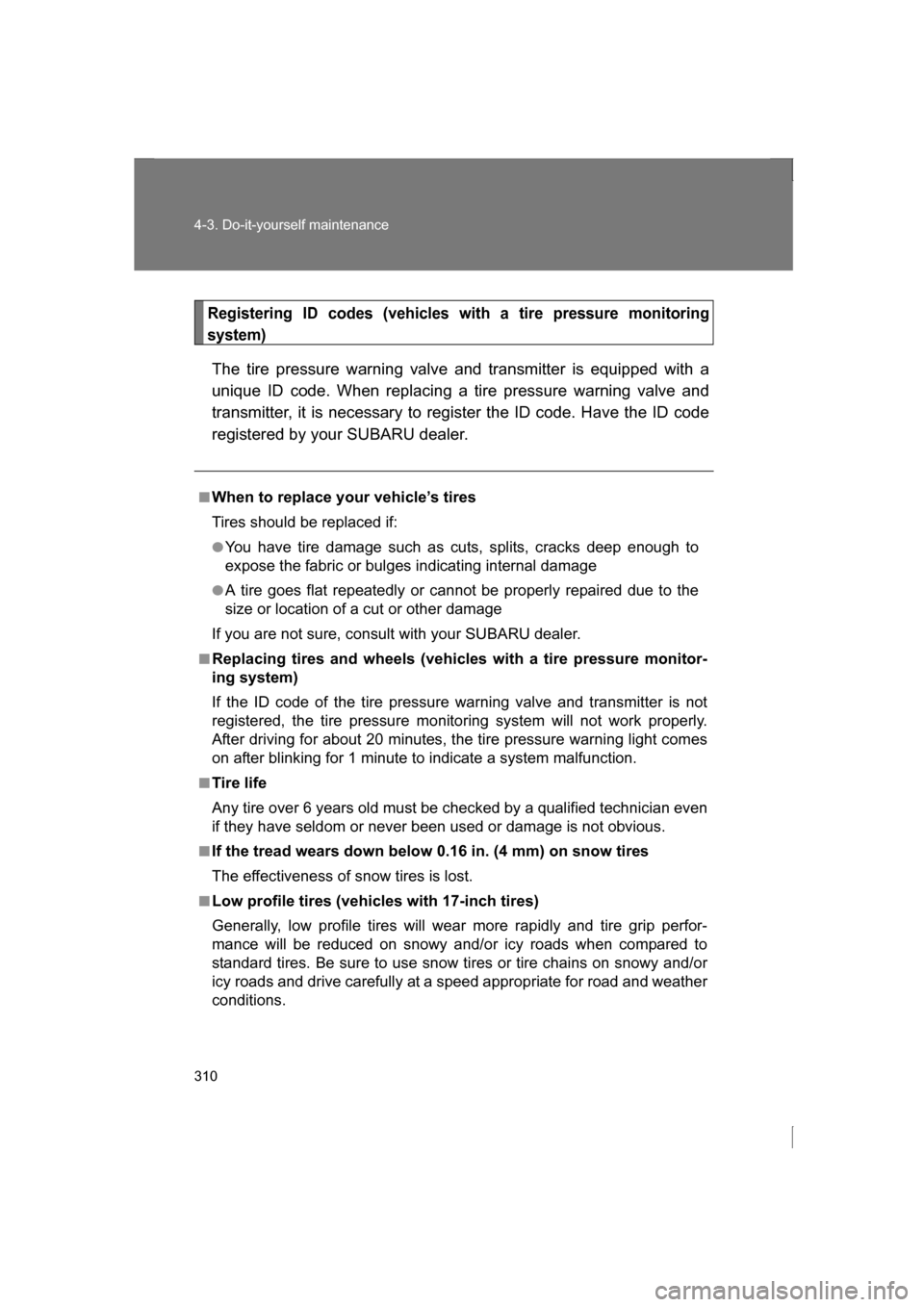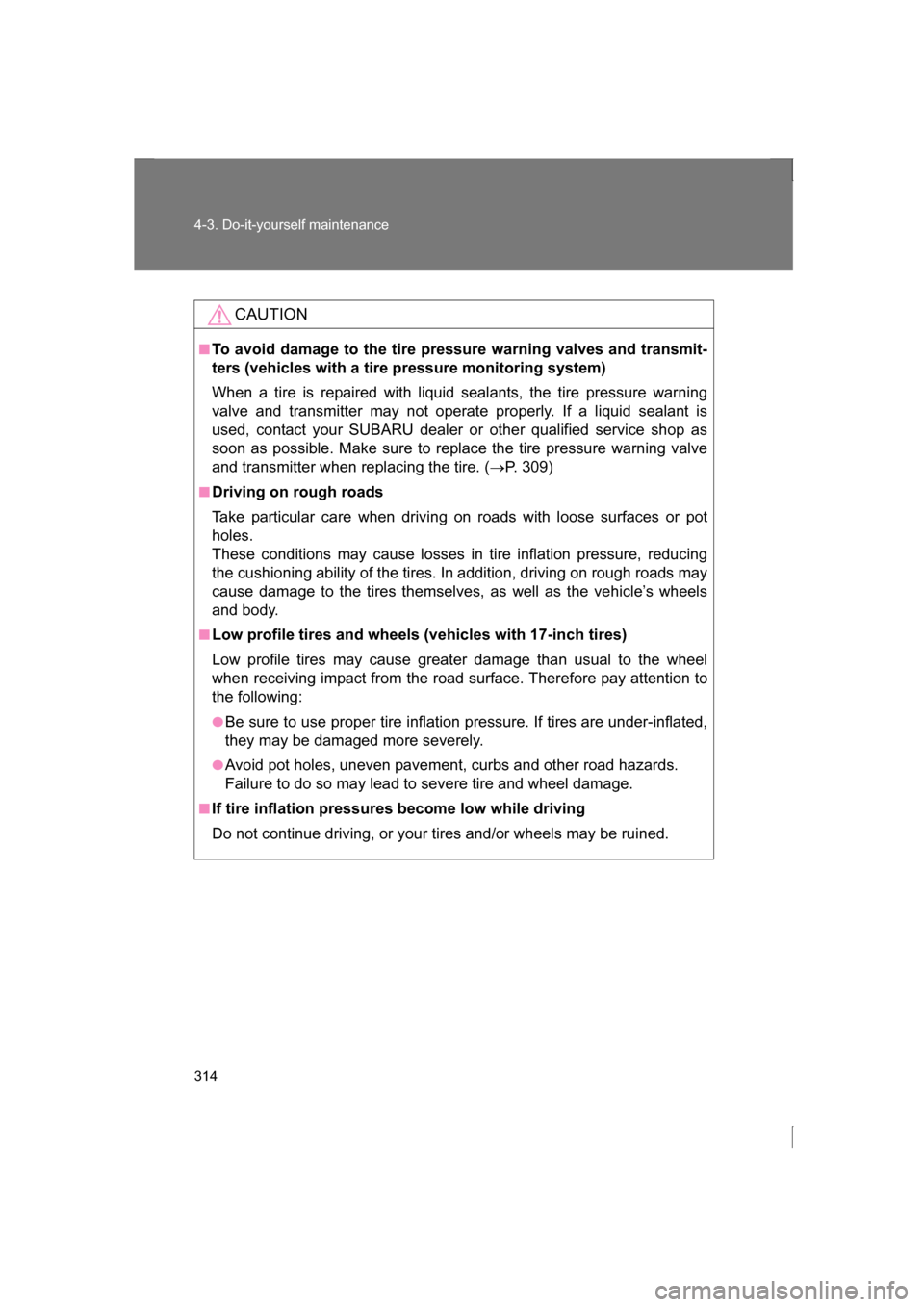Page 310 of 484

310
4-3. Do-it-yourself maintenance
Registering ID codes (vehicles with a tire pressure monitoring
system)
The tire pressure warning valve and transmitter is equipped with a
unique ID code. When replacing a tire pressure warning valve and
transmitter, it is necessary to register the ID code. Have the ID code
registered by your SUBARU dealer.
■When to replace your vehicle’s tires
Tires should be replaced if:
●You have tire damage such as cuts, splits, cracks deep enough to
expose the fabric or bulges indicating internal damage
●A tire goes flat repeatedly or cannot be properly repaired due to the
size or location of a cut or other damage
If you are not sure, consult with your SUBARU dealer.
■Replacing tires and wheels (vehicles with a tire pressure monitor-
ing system)
If the ID code of the tire pressure warning valve and transmitter is not
registered, the tire pressure monitoring system will not work properly.
After driving for about 20 minutes, the tire pressure warning light comes
on after blinking for 1 minute to indicate a system malfunction.
■Tire life
Any tire over 6 years old must be checked by a qualified technician even
if they have seldom or never been used or damage is not obvious.
■If the tread wears down below 0.16 in. (4 mm) on snow tires
The effectiveness of snow tires is lost.
■Low profile tires (vehicles with 17-inch tires)
Generally, low profile tires will wear more rapidly and tire grip perfor-
mance will be reduced on snowy and/or icy roads when compared to
standard tires. Be sure to use snow tires or tire chains on snowy and/or
icy roads and drive carefully at a speed appropriate for road and weather
conditions.
Page 314 of 484

314
4-3. Do-it-yourself maintenance
CAUTION
■To avoid damage to the tire pressure warning valves and transmit-
ters (vehicles with a tire pressure monitoring system)
When a tire is repaired with liquid sealants, the tire pressure warning
valve and transmitter may not operate properly. If a liquid sealant is
used, contact your SUBARU dealer or other qualified service shop as
soon as possible. Make sure to replace the tire pressure warning valve
and transmitter when replacing the tire. (→P. 309)
■Driving on rough roads
Take particular care when driving on roads with loose surfaces or pot
holes.
These conditions may cause losses in tire inflation pressure, reducing
the cushioning ability of the tires. In addition, driving on rough roads may
cause damage to the tires themselves, as well as the vehicle’s wheels
and body.
■Low profile tires and wheels (vehicles with 17-inch tires)
Low profile tires may cause greater damage than usual to the wheel
when receiving impact from the road surface. Therefore pay attention to
the following:
●Be sure to use proper tire inflation pressure. If tires are under-inflated,
they may be damaged more severely.
●Avoid pot holes, uneven pavement, curbs and other road hazards.
Failure to do so may lead to severe tire and wheel damage.
■If tire inflation pressures become low while driving
Do not continue driving, or your tires and/or wheels may be ruined.
Page 318 of 484
318
4-3. Do-it-yourself maintenance
WARNING
■Proper inflation is critical to save tire performance
Keep your tires properly inflated. Otherwise, the following conditions
may occur and result in an accident causing death or serious injury.
●Excessive wear
●Uneven wear
●Poor handling
●Possibility of blowouts resulting from overheated tires
●Poor sealing of the tire bead
●Wheel deformation and/or tire separation
●A greater possibility of tire damage from road hazards
CAUTION
■When inspecting and adjusting tire inflation pressure
Be sure to reinstall the tire valve caps.
Without the valve caps, dirt or moisture could get into the valve and
cause air leakage, which could result in an accident. If the caps have
been lost, replace them as soon as possible.
Page 322 of 484
322
4-3. Do-it-yourself maintenance
Air conditioning filter
The air conditioning filter must be changed regularly to maintain air
conditioning efficiency.
■Removal methodVehicles without a keyless access with push button
start system
Turn the engine switch off.
Vehicles with a keyless access with push button start
system
Turn the push-button ignition switch off. Open the glove box. Slide off
the damper.
Push in each side of the glove
box to disconnect the claws.
STEP 1
STEP 2
STEP 3
Page 323 of 484
323
4-3. Do-it-yourself maintenance
4
Maintenance and care
Pull out the glove box and dis-
connect the lower claws.
Remove the filter cover.
Remove the air conditioning
filter and replace it with a new
one.The “ ↑UP” marks shown on
the filter should be pointing up.STEP 4
STEP 5
STEP 6
Page 324 of 484
324
4-3. Do-it-yourself maintenance
■Checking interval
Inspect and replace the air conditioning filter according to the maintenance
schedule. In dusty areas or areas with heavy traffic flow, early replacement
may be required. (For scheduled maintenance information, please refer to
the “Warranty and Maintenance Booklet”.)
■If air flow from the vents decreases dramatically
The filter may be clogged. Check the filter and replace if necessary.
CAUTION
■When using the air conditioning system
Make sure that a filter is always installed.
Using the air conditioning system wit hout a filter may cause damage to the
system.
Page 332 of 484
332
4-3. Do-it-yourself maintenance
Fuse layout and amperage ratings
■Engine compartment
FuseAmpereCircuit
1 MIR HTR 7.5 A Outside rear view mirror defoggers
2 RDI 25 A Electric cooling fan
3 (PUSH-AT) 7.5 A Engine control unit
4 ABS NO. 1 40 A ABS
5 HEATER 50 A Air conditioning system
6 WASHER 10 A Windshield washer
7 WIPER 30 A Windshield wipers
8 RR DEF 30 A Rear window defogger
9 (RR FOG) 10 A
10 D FR DOOR 25 A Power window (driver’s side)
11 (CDS) 25 A Electric cooling fan
12 D-OP 25 A
13 ABS NO. 2 25 A ABS
14 D FL DOOR 25 A Power window (passenger’s side)
15 SPARE See note. Spare fuse
Page 335 of 484
335
4-3. Do-it-yourself maintenance
4
Maintenance and care
■Instrument panel
FuseAmpereCircuit
1 ECU ACC 10 A Main body ECU, outside rear view
mirrors
2 P/POINT No.2 15 A Power outlet
3 PANEL 10 A Illumination
4 TAIL 10 A Tail lights
5 DRL 10 A Daytime running light system
6 STOP 7.5 A Stop lights
7 OBD 7.5 A On-board diagnosis system
8 HEATER-S 7.5 A Air conditioning system
9 HEATER 10 A Air conditioning system
10 FR FOG LH 10 A Left-hand front fog light
11 FR FOG RH 10 A Right-hand front fog light
12 BK/UP LP 7.5 A Back-up lights
13 ECU IG1 10 A ABS, electric power steering
14 AM1 7.5 A Starting system
15 AMP 15 A
16 AT UNIT 15 A Transmission
17 GAUGE 7.5 A Gauge and meters, keyless access
with push button start system
18 ECU IG2 10 A Engine control unit
19 SEAT HTR LH 10 A Left-hand seat heater
20 SEAT HTR RH 10 A Right-hand seat heater
21 RADIO 7.5 A
22 P/POINT No.1 15 A Power outlet